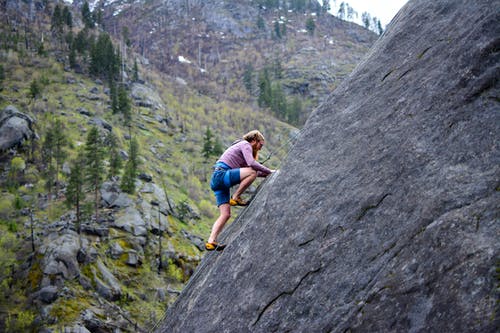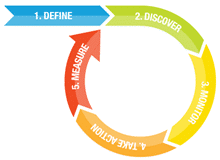
Table of Contents
ToggleEver wonder what technology can do for your wellness program?
You’re tasked with running a wellness program to promote health, prevent disease, and control healthcare costs. What do you need to be successful?
That’s a question expert climber Sir Edmund Hillary and his crew must have considered when they set out to summit Mount Everest in 1953. Many had tried to reach the peak of the 29,000-foot summit, but fell short of the goal. Hillary was determined to change that. And he did with the best gear and climbing technology of the time.
Are you using the best technology available to run your wellness program?
It’s the difference between climbing half way up the mountain and reaching the summit. Ask your C-Suite leadership team or your clients where they want to go, and they’ll all tell you they want to aim for reaching the summit.
How will you get there? The right technology will help you run a successful wellness program, much like it helped support Hillary’s expedition to Summit Everest.
Here are 5 ways technology drives wellness program success:
1. Identify risk factors
 Hillary and his crew needed to know all the dangers they would encounter to prepare to summit Everest. So they collected information from previous summit attempts, and other climbing parties. They monitored the weather. They studied known climbing routes.
Hillary and his crew needed to know all the dangers they would encounter to prepare to summit Everest. So they collected information from previous summit attempts, and other climbing parties. They monitored the weather. They studied known climbing routes.
It’s the kind of upfront work you need to do to run a successful wellness program. Technology makes it a lot easier to administer a health risk assessment, or collect and analyze biometric screening data.
Both of these population health metrics provide critical data to help you develop your wellness program, and web-based tools like these make it easier, more accurate, and faster to administer and analyze.
2. Develop interventions
Put yourself in Hillary’s shoes. What should you do if there’s an obstacle in the way, weather patterns predict dangerous weather, or a previous climbing route proved to be impassable? Find a better way.
Use technology to collect population health data, and you’ll have a rich resource of information to help you refine your wellness strategy. That could include hand-picked Wellness Challenges to address a specific risk factor, or Health Coaching to help employees eat healthier, exercise more, get preventive care, and develop healthy lifestyle habits.
Other tech-based wellness interventions can include access to a Health Education Library, mini quizzes, and done-for-you Wellness and Health Programs.
The right wellness technology makes it easy to create a report of population health risk factors and choose interventions that will have the biggest impact on disease prevention, productivity, and healthcare costs.
3. Measure results
 When Hillary reached the summit of Everest on May 29, 1953, it wasn’t by accident. He learned a lot from previous attempts, and other climbing expeditions that tried and failed. After each attempt, he took a closer look at the strategy and all the elements of an expedition to look for ways to improve.
When Hillary reached the summit of Everest on May 29, 1953, it wasn’t by accident. He learned a lot from previous attempts, and other climbing expeditions that tried and failed. After each attempt, he took a closer look at the strategy and all the elements of an expedition to look for ways to improve.
Is your wellness strategy working? Measure your results. Find out by using wellness technology to track things like year-to-year:
- Health risk assessment results
- Biometric screening results
- Participation rates
- Healthcare claims and costs
- Wellness program costs and ROI
4. Increase engagement
Climbing Everest generally isn’t a one-man expedition. It’s a team effort. The more people actively involved in making the climb, the more successful the expedition is going to be.
So how do you get more people involved in your wellness program? Use technology like:
Wellness Event Management tools to set appointments, send reminders, and motivate employees to make smart lifestyle choices. Send a group email or private message. Connect on social media. And keep participants informed.
Wearable Technology. Use a wellness platform that makes it easy to integrate wearable technology to capture participant data from smart watches, computes, and mobile apps. Research shows digital fitness trackers, devices and apps can help motivate people to make better choices.
Online Incentive Management to reward participants for completing wellness-related activities or achieving a health goal. The right tools automate the process for you, track points for participants, and provide an easy-to-manage experience to redeem the points for products and services.
5. Create a culture of health
 When Hillary and his climbing crew reached the summit of Everest, he accomplished the impossible. For decades, the tallest peak in the world eluded even the best climbers. Hillary’s successful ascent motivated the rest of the climbing community to keep trying and keep improving.
When Hillary and his climbing crew reached the summit of Everest, he accomplished the impossible. For decades, the tallest peak in the world eluded even the best climbers. Hillary’s successful ascent motivated the rest of the climbing community to keep trying and keep improving.
What happens when an employee shares their weight-loss success story with co-workers? Or shares pictures of their transformation on social media? People notice.
What happens when you create a friendly competition with a cash prize for the person who logs the most steps for a month? People get excited. Participation rates go up. Productivity rises. Healthcare costs start to decline.
Wellness technology makes it easier than ever to create a culture of health, inspire others, facilitate change, and reach the summit of your wellness program goals.
Gear up with proven wellness technology
If you want to run a successful wellness program, the right wellness technology tools can make your climb easier, faster, and more effective than relying on how it’s always been done.
Ready to rise to the top?.
See FitLyfe 360 in action







